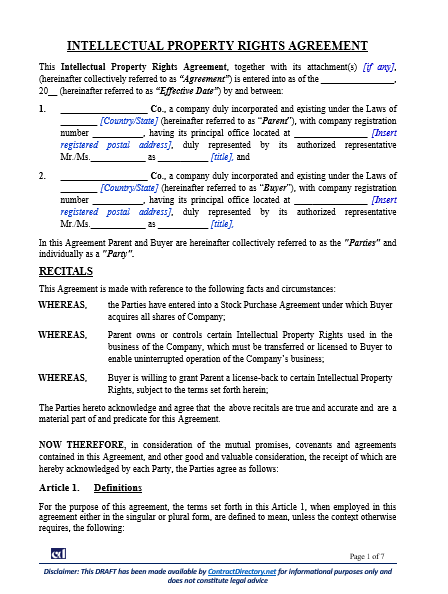Defining Intellectual Property Rights in Business
An Intellectual Property Rights Agreement is a legal framework designed to govern the ownership, transfer, and usage of intangible assets such as patents, trademarks, copyrights, and trade secrets. In mergers, acquisitions, or licensing arrangements, this agreement ensures that innovation remains both protected and monetized. It clarifies which party owns specific intellectual property (IP) and how each may use it after a business transaction. This structure safeguards companies from infringement disputes and ensures smooth continuity of operations when intellectual property changes hands.
Structure and Core Articles of the Agreement
This IP Rights Agreement follows a structured approach. It begins with Recitals outlining the relationship between the parties—typically a Parent and Buyer. Subsequent sections define key terms, including Assigned Intellectual Property, Licensed Intellectual Property, and Affiliate. Articles 2 to 5 address how ownership is transferred or licensed back.
For instance, the Parent assigns certain intellectual assets to the Buyer while retaining limited rights under a license-back clause. Later articles govern enforcement, warranties, indemnification, and confidentiality to ensure legal accountability. This layered structure allows both parties to maintain balanced rights while complying with global IP laws.

Key Legal Mechanisms and Protection
The IP Rights Contract establishes a clear roadmap for managing and enforcing intellectual assets. It covers issues like recordation of ownership, notification of infringement, and arbitration for disputes. It also restricts sublicensing or reassignment without consent, preserving the exclusivity of use. Clauses on warranties and indemnification protect each party from third-party claims or unauthorized use. The agreement further introduces force majeure and compliance provisions, ensuring obligations remain enforceable even under unforeseen circumstances. These mechanisms enhance business credibility and minimize legal risk in international transactions.
Practical Relevance and Global Implications
In today’s knowledge-driven economy, intellectual property holds immense strategic value. Businesses invest heavily in innovation, design, and technology, making IP management a cornerstone of competitive advantage. This agreement plays a crucial role in cross-border deals, where ownership must be clearly delineated to comply with jurisdictional laws.
Importance of Notary Acknowledgment in IP Agreements
Including a Notary Acknowledgment in an Intellectual Property Rights Agreement is a valuable safeguard for both parties. It formally verifies the identities and signatures of the signatories, ensuring that the agreement was executed willingly and with proper authority. This process enhances the document’s credibility and legal enforceability, particularly in international or high-value transactions. Moreover, notarization simplifies future registration or submission to governmental and intellectual property authorities, making it easier to prove authenticity in case of disputes or cross-border enforcement.
Related Intellectual Property and Legal Templates
- Copyright License Agreement
- Technology Transfer Agreement
- Non-Circumvention Non-Disclosure Agreement (NCNDA)
- Ownership Transfer Acknowledgement
References:
0
Related Topics: #IntellectualProperty #LegalContracts #Innovation #IPRights #BusinessLaw #ContractDirectory #Licensing #TechnologyLaw #IP
has been added to your cart!
have been added to your cart!



